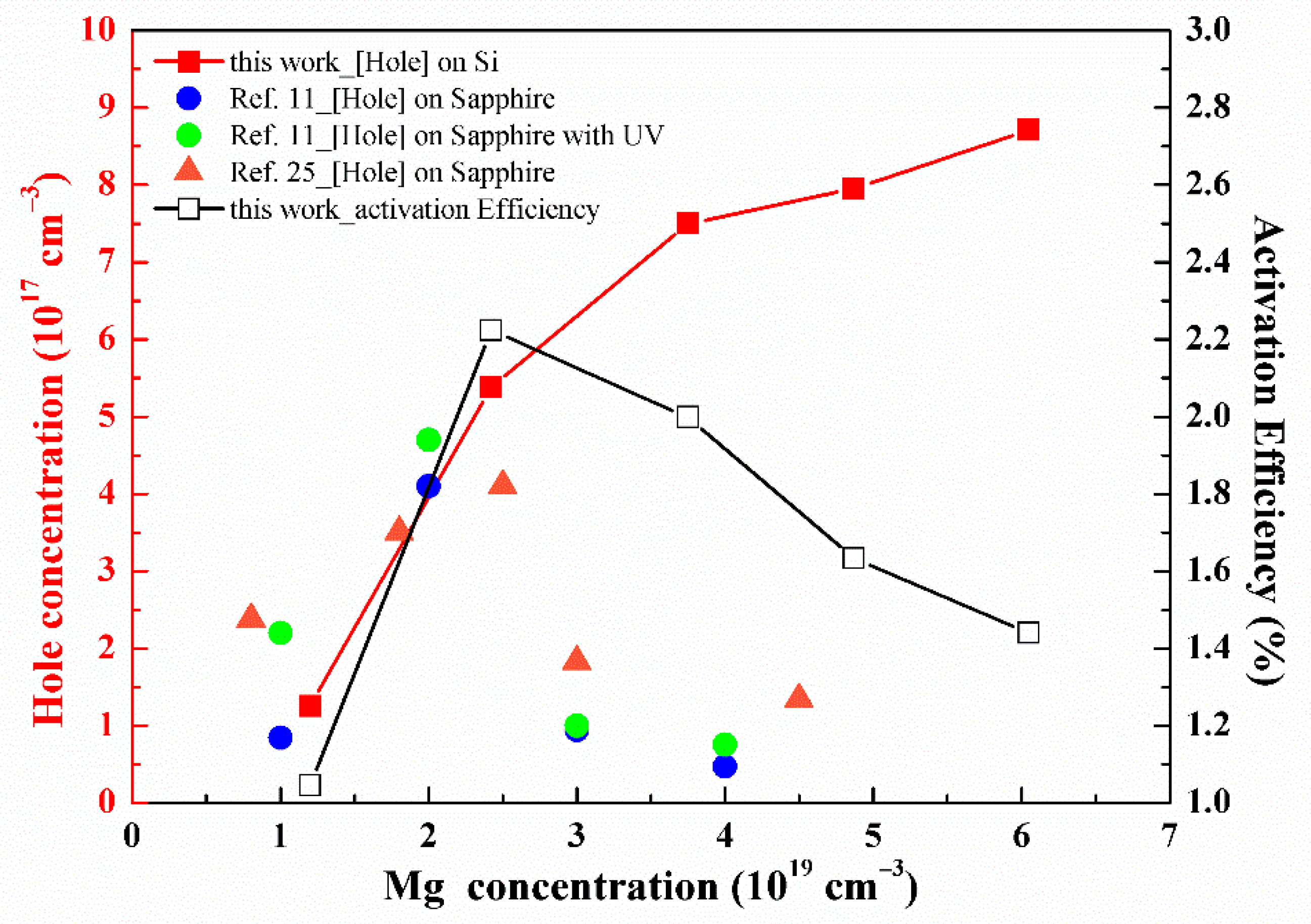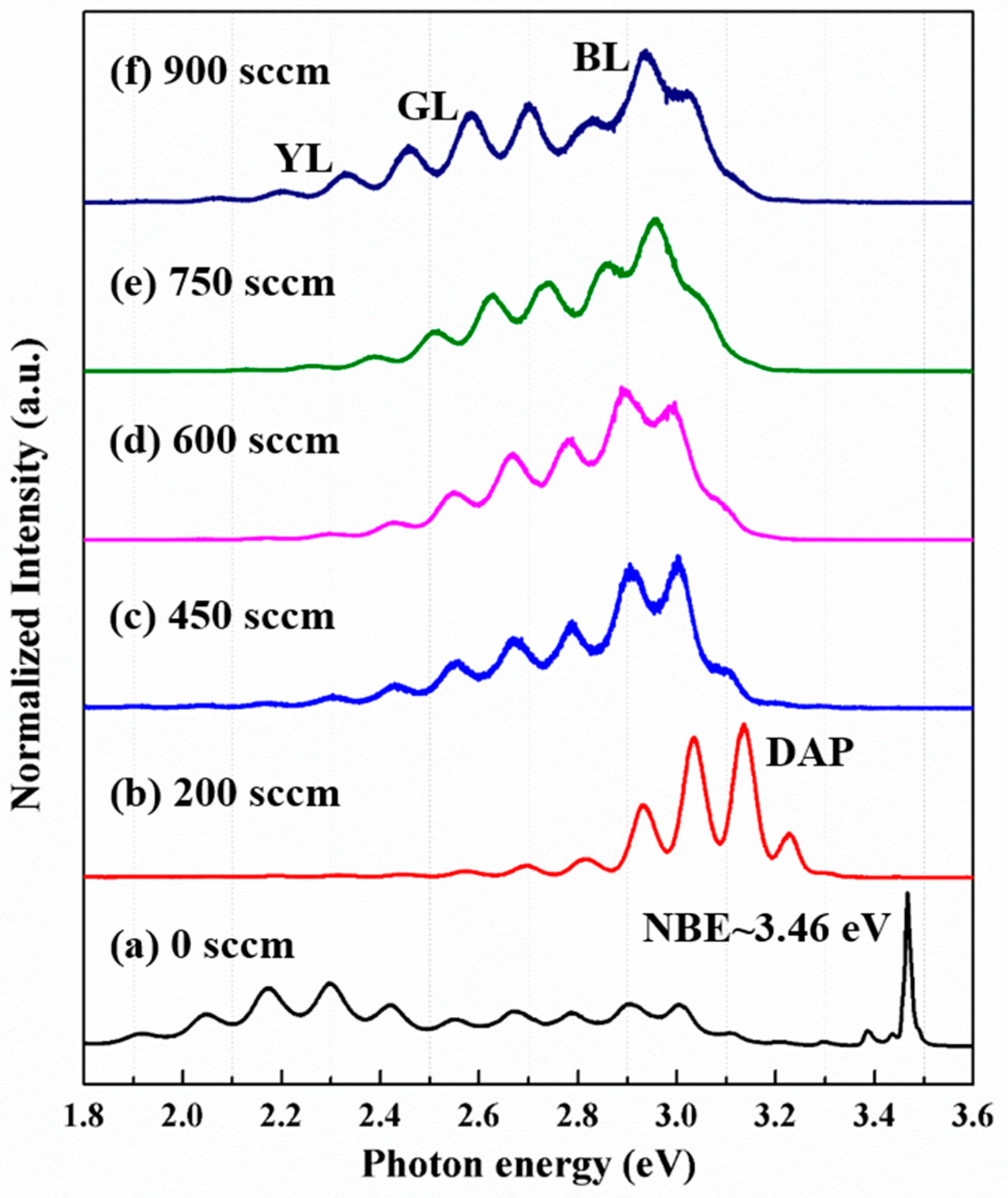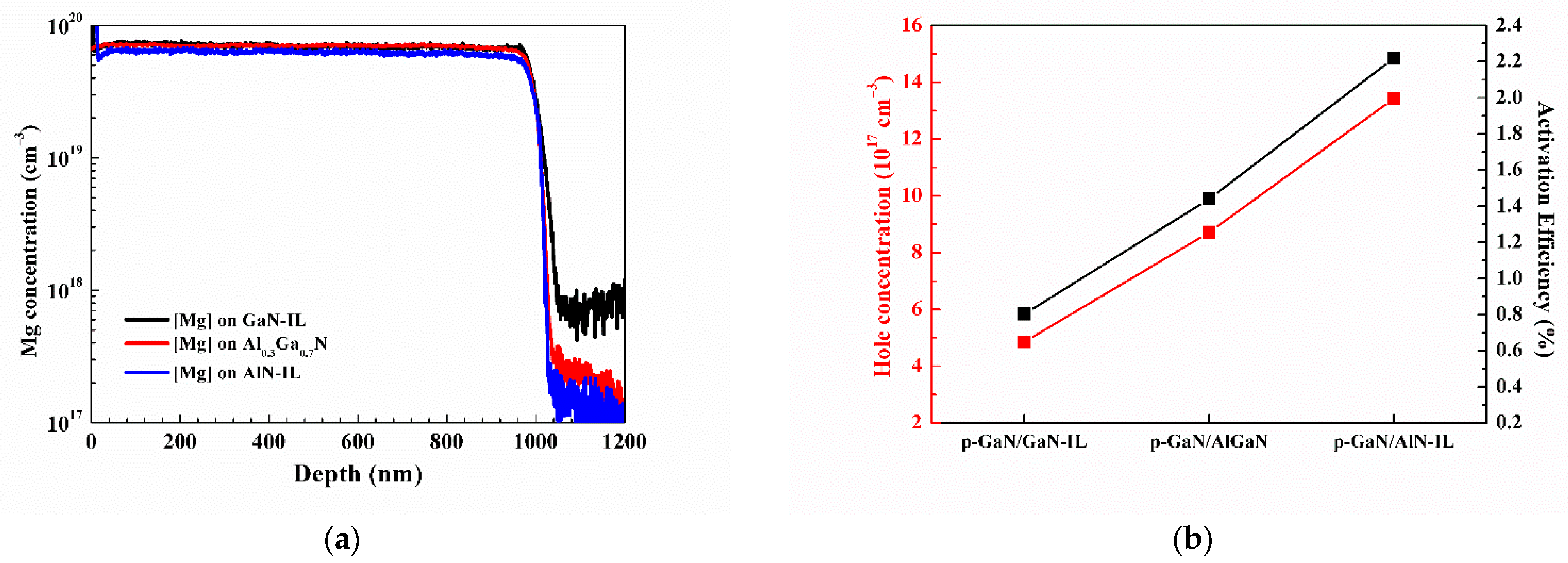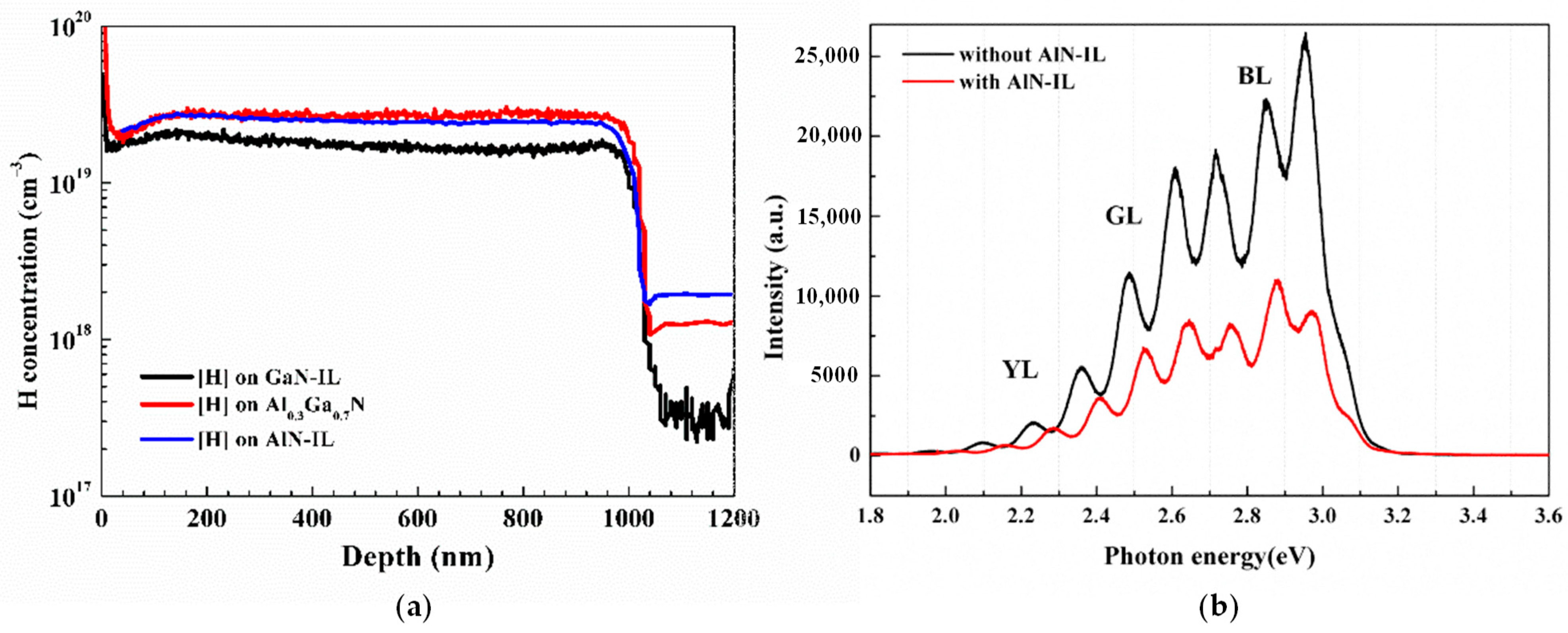High Hole Concentration and Diffusion Suppression of Heavily Mg-Doped p-GaN for Application in Enhanced-Mode GaN HEMT
Abstract
:1. Introduction
2. Materials and Methods
3. Results and Discussion
4. Conclusions
Author Contributions
Funding
Data Availability Statement
Conflicts of Interest
References
- Chen, K.J.; Haberlen, O.; Lidow, A.; Tsai, C.L.; Ueda, T.; Uemoto, Y.; Wu, Y. GaN-on-Si Power Technology: Devices and Applications. IEEE Trans. Electron. Devices 2017, 64, 779–795. [Google Scholar] [CrossRef]
- Chen, K.J.; Zhou, C. Enhancement-mode AlGaN/GaN HEMT and MIS-HEMT technology. Phys. Status Solidi (a) 2010, 208, 434–438. [Google Scholar] [CrossRef]
- Roccaforte, F.; Greco, G.; Fiorenza, P.; Iucolano, F. An Overview of Normally-Off GaN-Based High Electron Mobility Transistors. Materials 2019, 12, 1599. [Google Scholar] [CrossRef] [Green Version]
- Buckeridge, J.; Catlow, C.R.A.; Scanlon, D.O.; Keal, T.; Sherwood, P.; Miskufova, M.; Walsh, A.; Woodley, S.M.; Sokol, A. Determination of the Nitrogen Vacancy as a Shallow Compensating Center in GaN Doped with Divalent Metals. Phys. Rev. Lett. 2015, 114, 016405. [Google Scholar] [CrossRef] [PubMed] [Green Version]
- Sarkar, B.; Mita, S.; Reddy, P.; Klump, A.; Kaess, F.; Tweedie, J.; Bryan, I.; Bryan, Z.; Kirste, R.; Kohn, E.; et al. High free carrier concentration in p-GaN grown on AlN substrates. Appl. Phys. Lett. 2017, 111, 032109. [Google Scholar] [CrossRef]
- Sang, L.; Ren, B.; Endo, R.; Masuda, T.; Yasufuku, H.; Liao, M.; Nabatame, T.; Sumiya, M.; Koide, Y. Boosting the doping efficiency of Mg in p-GaN grown on the free-standing GaN substrates. Appl. Phys. Lett. 2019, 115, 172103. [Google Scholar] [CrossRef]
- Castiglia, A.; Carlin, J.-F.; Grandjean, N.R. Role of stable and metastable Mg–H complexes in p-type GaN for cw blue laser diodes. Appl. Phys. Lett. 2011, 98, 213505. [Google Scholar] [CrossRef]
- Wide range doping control and defect characterization of GaN layers with various Mg concentrations. J. Appl. Phys. 2018, 124, 165706. [CrossRef]
- Miceli, G.; Pasquarello, A. Self-compensation due to point defects in Mg-doped GaN. Phys. Rev. B 2016, 93, 93. [Google Scholar] [CrossRef] [Green Version]
- Kirste, R.; Hoffmann, M.P.; Tweedie, J.; Bryan, Z.; Callsen, G.; Kure, T.; Nenstiel, C.; Wagner, M.R.; Collazo, R.; Hoffmann, A.; et al. Compensation effects in GaN:Mg probed by Raman spectroscopy and photoluminescence measurements. J. Appl. Phys. 2013, 113, 103504. [Google Scholar] [CrossRef]
- Klump, A.; Hoffmann, M.P.; Kaess, F.; Tweedie, J.; Reddy, P.; Kirste, R.; Sitar, Z.; Collazo, R. Control of passivation and compensation in Mg-doped GaN by defect quasi Fermi level control. J. Appl. Phys. 2020, 127, 045702. [Google Scholar] [CrossRef]
- Figge, S.; Kröger, R.; Böttcher, T.; Ryder, P.L.; Hommel, D. Magnesium segregation and the formation of pyramidal defects in p-GaN. Appl. Phys. Lett. 2002, 81, 4748–4750. [Google Scholar] [CrossRef]
- Duguay, S.; Echeverri, A.; Castro, C.; Latry, O. Evidence of Mg Segregation to Threading Dislocation in Normally-Off GaN-HEMT. IEEE Trans. Nanotechnol. 2019, 18, 995–998. [Google Scholar] [CrossRef]
- Posthuma, N.; You, S.; Liang, H.; Ronchi, N.; Kang, X.; Wellekens, D.; Saripalli, Y.; Decoutere, S. Impact of Mg out-diffusion and activation on the p-GaN gate HEMT device performance. In Proceedings of the 2016 28th International Symposium on Power Semiconductor Devices and ICs (ISPSD), Prague, Czech Republic, 12–16 June 2016; pp. 95–98. [Google Scholar]
- He, J.; Tang, G.; Chen, K.J. VTH Instability of p-GaN Gate HEMTs under Static and Dynamic Gate Stress. IEEE Electron. Device Lett. 2018, 39, 1. [Google Scholar] [CrossRef]
- Chen, Y.; Wu, H.; Yue, G.; Chen, Z.; Zheng, Z.; Wu, Z.; Wang, G.; Jiang, H. Enhanced Mg Doping Efficiency in P-Type GaN by Indium-Surfactant-Assisted Delta Doping Method. Appl. Phys. Express 2013, 6, 041001. [Google Scholar] [CrossRef]
- Nayak, S.; Gupta, M.; Waghmare, U.V.; Shivaprasad, S. Origin of Blue Luminescence in Mg -Doped GaN. Phys. Rev. Appl. 2019, 11, 014027. [Google Scholar] [CrossRef] [Green Version]
- Liu, H.; Fu, H.; Fu, K.; Alugubelli, S.R.; Su, P.-Y.; Zhao, Y.; Ponce, F.A. Non-uniform Mg distribution in GaN epilayers grown on mesa structures for applications in GaN power electronics. Appl. Phys. Lett. 2019, 114, 082102. [Google Scholar] [CrossRef] [Green Version]
- Efthymiou, L.; Murukesan, K.; Longobardi, G.; Udrea, F.; Shibib, A.; Terrill, K. Understanding the Threshold Voltage Instability During OFF-State Stress in p-GaN HEMTs. IEEE Electron. Device Lett. 2019, 40, 1253–1256. [Google Scholar] [CrossRef]
- Chen, J.; Yi, W.; Kimura, T.; Takashima, S.; Edo, M.; Sekiguchi, T. Cathodoluminescene study of Mg implanted GaN: The impact of dislocation on Mg diffusion. Appl. Phys. Express 2019, 12, 051010. [Google Scholar] [CrossRef]
- Usami, S.; Mayama, N.; Toda, K.; Tanaka, A.; Deki, M.; Nitta, S.; Honda, Y.; Amano, H. Direct evidence of Mg diffusion through threading mixed dislocations in GaN p–n diodes and its effect on reverse leakage current. Appl. Phys. Lett. 2019, 114, 232105. [Google Scholar] [CrossRef]
- Yi, W.; Kumar, A.; Uzuhashi, J.; Kimura, T.; Tanaka, R.; Takashima, S.; Edo, M.; Yao, Y.; Ishikawa, Y.; Chen, J.; et al. Mg diffusion and activation along threading dislocations in GaN. Appl. Phys. Lett. 2020, 116, 242103. [Google Scholar] [CrossRef]
- Chiu, H.-C.; Chang, Y.-S.; Li, B.-H.; Wang, H.-C.; Kao, H.-L.; Hu, C.-W.; Xuan, R. High-Performance Normally Off p-GaN Gate HEMT With Composite AlN/Al0.17Ga0.83N/Al0.3Ga0.7N Barrier Layers Design. IEEE J. Electron. Devices Soc. 2018, 6, 201–206. [Google Scholar] [CrossRef]
- Chiu, H.-C.; Chang, Y.-S.; Li, B.-H.; Wang, H.-C.; Kao, H.-L.; Chien, F.-T.; Hu, C.-W.; Xuan, R. High Uniformity Normally-OFF p-GaN Gate HEMT Using Self-Terminated Digital Etching Technique. IEEE Trans. Electron. Devices 2018, 65, 4820–4825. [Google Scholar] [CrossRef]
- Qi, H.; Zhang, S.; Liu, S.; Liang, F.; Yi, L.; Huang, J.; Zhou, M.; He, Z.; Zhao, D.; Jiang, D. The self-compensation effect of heavily Mg doped p-GaN films studied by SIMS and photoluminescence. Superlattices Microstruct. 2019, 133, 106177. [Google Scholar] [CrossRef]
- Yan, Q.; Janotti, A.; Scheffler, M.; Van De Walle, C.G. Role of nitrogen vacancies in the luminescence of Mg-doped GaN. Appl. Phys. Lett. 2012, 100, 142110. [Google Scholar] [CrossRef]
- Reshchikov, M.A.; Demchenko, D.O.; McNamara, J.D.; Fernández-Garrido, S.; Calarco, R. Green luminescence in Mg-doped GaN. Phys. Rev. B 2014, 90, 90. [Google Scholar] [CrossRef] [Green Version]
- Remmele, T.; Albrecht, M.; Irmscher, K.; Fornari, R.; Straßburg, M. Pyramidal inversion domain boundaries revisited. Appl. Phys. Lett. 2011, 99, 141913. [Google Scholar] [CrossRef]
- Iwata, K.; Narita, T.; Nagao, M.; Tomita, K.; Kataoka, K.; Kachi, T.; Ikarashi, N. Atomic resolution structural analysis of magnesium segregation at a pyramidal inversion domain in a GaN epitaxial layer. Appl. Phys. Express 2019, 12, 031004. [Google Scholar] [CrossRef]
- Hansen, M.; Chen, L.F.; Lim, S.H.; DenBaars, S.P.; Speck, J.S. Mg-rich precipitates in the p-type doping of InGaN-based laser diodes. Appl. Phys. Lett. 2002, 80, 2469–2471. [Google Scholar] [CrossRef]
- Vennéguès, P.; Leroux, M.; Dalmasso, S.; Benaissa, M.; De Mierry, P.; Lorenzini, P.; Damilano, B.; Beaumont, B.; Massies, J.; Gibart, P. Atomic structure of pyramidal defects in Mg-doped GaN. Phys. Rev. B 2003, 68, 68. [Google Scholar] [CrossRef]
- Reshchikov, M.A.; Yi, G.-C.; Wessels, B.W. Behavior of 2.8- and 3.2-eV photoluminescence bands in Mg-doped GaN at different temperatures and excitation densities. Phys. Rev. B 1999, 59, 13176–13183. [Google Scholar] [CrossRef]
- Kaufmann, U.; Kunzer, M.; Maier, M.; Obloh, H.; Ramakrishnan, A.; Santic, B.; Schlotter, P. Nature of the 2.8 eV photoluminescence band in Mg doped GaN. Appl. Phys. Lett. 1998, 72, 1326–1328. [Google Scholar] [CrossRef]
- Kojima, K.; Takashima, S.; Edo, M.; Ueno, K.; Shimizu, M.; Takahashi, T.; Ishibashi, S.; Uedono, A.; Chichibu, S. Nitrogen vacancies as a common element of the green luminescence and nonradiative recombination centers in Mg-implanted GaN layers formed on a GaN substrate. Appl. Phys. Express 2017, 10, 061002. [Google Scholar] [CrossRef]
- Oh, E.; Park, H.; Park, Y. Excitation density dependence of photoluminescence in GaN:Mg. Appl. Phys. Lett. 1998, 72, 70–72. [Google Scholar] [CrossRef]
- Viswanath, A.K.; Shin, E.-J.; Lee, J.I.; Yu, S.; Kim, N.; Kim, B.; Choi, Y.; Hong, C.-H. Magnesium acceptor levels in GaN studied by photoluminescence. J. Appl. Phys. 1998, 83, 2272–2275. [Google Scholar] [CrossRef]
- Lin, P.-J.; Tien, C.-H.; Wang, T.-Y.; Chen, C.-L.; Ou, S.-L.; Chung, B.-C.; Wuu, D.-S. On the Role of AlN Insertion Layer in Stress Control of GaN on 150-mm Si (111) Substrate. Crystals 2017, 7, 134. [Google Scholar] [CrossRef] [Green Version]
- Dai, J.-J.; Liu, C.-W.; Wu, S.-K.; Huynh, S.-H.; Jiang, J.-G.; Yen, S.-A.; Mai, T.T.; Wen, H.-C.; Chou, W.-C.; Hu, C.-W.; et al. Improving Transport Properties of GaN-Based HEMT on Si (111) by Controlling SiH4 Flow Rate of the SiNx Nano-Mask. Coatings 2020, 11, 16. [Google Scholar] [CrossRef]
- Flynn, C.; Lee, W. The dependence of Raman scattering on Mg concentration in Mg-doped GaN grown by MBE. Mater. Res. Express 2014, 1, 25901. [Google Scholar] [CrossRef]
- Kisielowski, C.; Krüger, J.; Ruvimov, S.; Suski, T.; Ager III, J.; Jones, E.; Liliental-Weber, Z.; Rubin, M.; Weber, E.; Bremser, M. Strain-related phenomena in GaN thin films. Phys. Rev. B 1996, 54, 17745. [Google Scholar] [CrossRef] [Green Version]
- Ning-Yang, L.; Lei, L.; Lei, W.; Wei, Y.; Ding, L.; Lei, L.; Wen-Yu, C.; Ci-Mang, L.; Cheng-Hao, W.; Wei-Hua, C. Improvement of doping efficiency in Mg-Al0. 14Ga0. 86N/GaN superlattices with AlN interlayer by suppressing donor-like defects. Chin. Phys. B 2012, 21, 117304. [Google Scholar]
- Wang, L.; Li, R.; Li, D.; Liu, N.; Liu, L.; Chen, W.; Wang, C.; Yang, Z.; Hu, X. Strain modulation-enhanced Mg acceptor activation efficiency of Al0.14Ga0.86N/GaN superlattices with AlN interlayer. Appl. Phys. Lett. 2010, 96, 061110. [Google Scholar] [CrossRef]
- Lyons, J.L.; Janotti, A.; Van De Walle, C.G. Shallow versus Deep Nature of Mg Acceptors in Nitride Semiconductors. Phys. Rev. Lett. 2012, 108, 156403. [Google Scholar] [CrossRef] [Green Version]
- Reddy, P.; Bryan, Z.; Bryan, I.; Kim, J.H.; Washiyama, S.; Kirste, R.; Mita, S.; Tweedie, J.; Irving, D.L.; Sitar, Z.; et al. Pinning of energy transitions of defects, complexes, and surface states in AlGaN alloys. Appl. Phys. Lett. 2020, 116, 032102. [Google Scholar] [CrossRef]





| Structure | Cp2Mg Source (sccm) | Mg Doping Concentration (cm−3) | Hole Concentration (cm−3) | Mobility (cm2/V-s) | Resistivity (ohm-cm) | Activation Efficiency (%) |
|---|---|---|---|---|---|---|
| p-GaN/Al0.3Ga0.7N | 200 | 1.20 × 1019 | (1.25 ± 0.06) × 1017 | 27.54 ± 1.38 | 1.87 ± 0.09 | 1.04 |
| 450 | 2.42 × 1019 | (5.38 ± 0.27) × 1017 | 7.69 ± 0.38 | 1.51 ± 0.08 | 2.22 | |
| 600 | 3.75 × 1019 | (7.49 ± 0.37) × 1017 | 5.63 ± 0.28 | 1.48 ± 0.07 | 2.00 | |
| 750 | 4.87 × 1019 | (7.95 ± 0.40) × 1017 | 4.51 ± 0.23 | 1.74 ± 0.09 | 1.63 | |
| 900 | 6.05 × 1019 | (8.71 ± 0.44) × 1017 | 3.54 ± 0.18 | 2.02 ± 0.10 | 1.44 |
Publisher’s Note: MDPI stays neutral with regard to jurisdictional claims in published maps and institutional affiliations. |
© 2021 by the authors. Licensee MDPI, Basel, Switzerland. This article is an open access article distributed under the terms and conditions of the Creative Commons Attribution (CC BY) license (https://creativecommons.org/licenses/by/4.0/).
Share and Cite
Dai, J.-J.; Mai, T.T.; Wu, S.-K.; Peng, J.-R.; Liu, C.-W.; Wen, H.-C.; Chou, W.-C.; Ho, H.-C.; Wang, W.-F. High Hole Concentration and Diffusion Suppression of Heavily Mg-Doped p-GaN for Application in Enhanced-Mode GaN HEMT. Nanomaterials 2021, 11, 1766. https://doi.org/10.3390/nano11071766
Dai J-J, Mai TT, Wu S-K, Peng J-R, Liu C-W, Wen H-C, Chou W-C, Ho H-C, Wang W-F. High Hole Concentration and Diffusion Suppression of Heavily Mg-Doped p-GaN for Application in Enhanced-Mode GaN HEMT. Nanomaterials. 2021; 11(7):1766. https://doi.org/10.3390/nano11071766
Chicago/Turabian StyleDai, Jin-Ji, Thi Thu Mai, Ssu-Kuan Wu, Jing-Rong Peng, Cheng-Wei Liu, Hua-Chiang Wen, Wu-Ching Chou, Han-Chieh Ho, and Wei-Fan Wang. 2021. "High Hole Concentration and Diffusion Suppression of Heavily Mg-Doped p-GaN for Application in Enhanced-Mode GaN HEMT" Nanomaterials 11, no. 7: 1766. https://doi.org/10.3390/nano11071766
APA StyleDai, J.-J., Mai, T. T., Wu, S.-K., Peng, J.-R., Liu, C.-W., Wen, H.-C., Chou, W.-C., Ho, H.-C., & Wang, W.-F. (2021). High Hole Concentration and Diffusion Suppression of Heavily Mg-Doped p-GaN for Application in Enhanced-Mode GaN HEMT. Nanomaterials, 11(7), 1766. https://doi.org/10.3390/nano11071766







